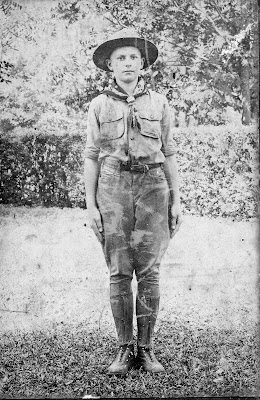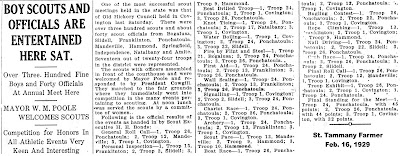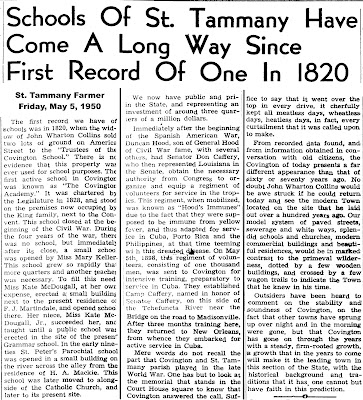Here's a group picture of a number of faithful volunteers serving the various senior citizens groups in St. Tammany Parish in 1977.
Tuesday, February 28, 2023
Boy Scouts Troop 1
Here is a group picture that was identified as Boy Scout Troop 1 in Covington, LA. Click on the image to make it larger.
In 1927 the local Troop 1, Boy Scouts of America, received its ten year charter. Here's an article from the St. Tammany Farmer detailing that event.
Christmas Boat Parade
The Madisonville Christmas boat parade brought out a large number of folks along the riverfront.
Tax Sale Bonanza
The periodic sale of properties with delinquent payment of property taxes resulted in some spirited events, as dozens of people crowded into the lobby of the old courthouse.
Wednesday, February 22, 2023
Spring Fiesta Home Tours Draw Thousands
One of the ways in which St. Tammany Parish introduced itself to the world, both to out of parish visitors as well as residents, was the annual Spring Fiesta Home Tours. Some of the largest brought in thousands of curious visitors, many of those from New Orleans. The Fiesta Tour held in 1939 was especially successful.
The event was big news
Tuesday, February 21, 2023
Covington Mardi Gras Get Ready
Here are some photographs of the floats and cars that were in the Mardi Gras parades in Covington on Tuesday, Feb. 21, 2023. Click on the images to make them larger.
Mardi Gras Parade Preparations
Olympia Mardi Gras History
Covington Mardi Gras 1982
More Covington Mardi Gras Pictures - 1982
Madisonville Mardi Gras - 1982
Mardi Gras Pageantry in 1911
Mardi Gras Years Ago
First Mardi Gras Queen in Covington
The Man Who Brought Mardi Gras to Covington
Madisonville Mardi Gras - 1973
Mardi Gras Cup Map
Kindergarten Class - 1960
Civic Club Carnival
More Mardi Gras 1982
Friday, February 17, 2023
Schools Have Come a Long Way
The history of schools and education in St. Tammany Parish was the subject of a history article published in the St. Tammany Farmer in May of 1950. Here is a clipping of that article.
The text of the article can be found below:
St. Tammany Farmer Friday, May 5, 1950
Schools of St. Tammany Have Come a Long Way
The first record we have of schools was in 1820, when the widow of John Wharton Collins sold two lots of ground on America Street to the "Trustees of the Covington School." There is no evidence that this property was ever used for school purposes.
The first active school in Covington was known as "The Covington Academy." It was chartered by the Legislature in 1828, and stood on the premises now occupied by the King family, next to the Convent. This school closed at the beginning of the Civil War.
During the four years of the war, there was no school, brut immediately after its close, a small school was opened by Miss Mary Keller his school grew so rapidly that more quarters and another teacher was necessary. To fill this need Miss Kate McDougall, at her own expense, erected a small building next to the present residence of F. J. Martindale, and opened school there.
Her niece, Miss Kate McDougall, Jr., succeeded her, and taught until a public school was erected in the site of the present Grammar school. In the early nineties St. Peter's Parochial school was opened in a small building on the river across the alley from the residence of H. A. Mackie. This school was later moved to alongside of the Catholic Church, and later to its present site.
We now have public and private in the State, and representing an investment of around three quarters of a million dollars.
Hoods Immunes
Immediately after the beginning of the Spanish American War, Duncan Hood, son of General Hood of Civil War fame, with several others, had Senator Don Caffery, who then represented Louisiana in the Senate, obtain the necessary authority from Congress to organize and equip a regiment of volunteers for service in the tropics. This regiment, when mobilized, was known as "Hood's Immunes" due to the fact that they were supposed to be immune from yellow fever, and thus adapted for service in Cuba, Porto Rica and the Philippines, at that time teeming with this dreaded disease.
On May 5th, 1898, this regiment of volunteers, consisting of one thousand men, was sent to Covington for intensive training, preparatory to service in Cuba. They established Camp Caffery, named in honor of Senator Caffery, on this side of the Tchefuncta River near the bridge on the road to Madisonville. After three months training here, they returned to New Orleans, from whence they embarked for active service in Cuba.
World War One
Mere words do not recall the part that Covington and St. Tammany parish played in the late World War. One has but to look at the memorial that stands in the Court House square to know that Covington answered the call. Suffice to say that it went over the top in every drive, it cheerfully kept all meatless days, wheatless days, heatless days, in fact, every curtailment that it was called upon to make.
Covington of 1950
From recorded data found, and from information obtained in conversation with old citizens, the Covington of today presents a far different appearance than that of sixty or seventy years ago. No doubt John Wharton Collins would be awe struck if he could return, today and see the modern Town located on the site that he laid out over a hundred years ago.
Our model system of paved streets, sewerage and white ways, splendid schools and churches, modern commercial buildings and beautiful residences, would be in marked contrast to the primeval wilderness, dotted by a few wooden buildings, and crossed by a few wagon trails to indicate the Town that he knew in his time.
Outsiders have been heard to comment on the stability and soundness of Covington, on the fact that other towns have sprung up over night and in the morning were gone, but that Covington has gone on through the years with a steady, firm-rooted growth, is growth that in the years to come will make it the leading town in this section of the State, with the historical background and traditions that it has, one cannot but have faith in this prediction.
See also:
Thursday, February 16, 2023
Brief History of Covington
In April of 1950, a brief history of the Covington area was published in the St. Tammany Farmer newspaper. It went as follows:
"In order for one to get a proper insight into the early history of Covington, it is necessary to pause a moment and observe the mad scramble that several of the European nations were having for possesions in this country.
"The French, who were recognized as the first to reach these shores, LaSalle having landed at the mouth of the Mississippi in 1681, retained control of this territory until 1763, when the British captured Baton Rouge. The British flag was the recognized standard until 1779, when the Spanish gained control, and the Spanish flag waved over this section of Louisiana.
"The French in 1800 again obtained this territory, but did not take possession of same until 1803. A few days later, Napoleon, then Emperor of France transferred the teritory to the United States by act of sale, known of "The Louisiana Purchase."
"However, the United States) did not take possession until 1810. The settlers in the meantime, fearing that the United States would not assume control formed an independent government, known as West Florida, with Baton Rouge as the capitol. This regime was short lived, as eight days later Governor Claiborne, appointed by the United States Government to administer affairs in Louisiana, arrived and took possession.
"With this background before us, we now come to St. Tammany parish and see what was happening around the section comprised between the Tchefuncta and Bogue Falaya rivers.
"In 1785 a small band of pioneers, most of whom were from the Blue Grass regions of Kentucky, founded a settlement on the banks of the Bogue Falaya river, which they called "Wharton" in honor of John Wharton Collins, one of the members of their colony. Things went along smoothly for the next few years, with no automobiles to dodge, eternal triangles to solve or stock market crashes to worry the natives, until 1812 when Wharton was made the parish seat of St. Tammany parish, it having been formerly on the East bank of the River at the present site of Claiborne.
"On March 19th, 1814, John Wharton Collins, who then owned all of the land within the present corporate limits of the Town of Covington, deposited in the Clerk of Court's office, a map of St. John of Wharton, and dedicated to the public all streets, alleys, public squares, etc., as shown on said map.
"This map or survey is now known as the Division of St. John of the Town of Covington, and embraces all of the business or central part of same. There was afterwards added to this original section, the Divisions of Spring, Summer, Autumn, Wayside and other small Divisions, the whole constituting what is known as "Old Covington."
"It was not until 1888, that the Covington & St. Tammany Land & Improvement Company acquired from Judge James Thompson a virgin tract of timber land North of Jefferson Avenue, and lying between the Holmesville Road on the East and the Tchefuncta river on the West. This tract of land, it platted and laid out as "New Covington," at that time opening up the Streets and Avenues as they exist today.
"This topographical Division of the Town has not changed up to the present day. In 1816 the Legislature changed the name from "Wharton" to "Covington" and in 1832 Covington was by an Act of the Legisulature classified as a Town, and a Charter as such issued to it.
"During the early years of its existence, in fact, up the time of the Civil War, Covington was entirely dependent upon water ways for transportation and movement of freight, however, it was this fact that contributed largely to the early growth and progress of the Town. Until the advent of roads all cotton, navel stores, and other goods from as North as Hattiesburg were brought Covington by ox team, to be shipped by boat to New Orleans, the Gulf Coast or other points.
"It was not until the I. C. Railroad was opened up through Mississippi that this extensive trade through Covington was discontinued.
"As an illustration of the importance of Covington as a port during this period, one instance is known where a grand piano was shipped from England to New Orleans, then to Covington by boat, where it was here loaded on an ox team and hauled to McComb, Missisippi. "
Saturday, February 11, 2023
Caroline Smith Renowned Ceramics Artist
In 1950, this article appeared in the St. Tammany Farmer, telling about the work of Carolyn Smith of Covington, who was winning numerous awards for her artwork in ceramics, jewelry, metal work and weaving. Click on the image below to make it larger and more readable.
Thursday, February 9, 2023
Frances Barker, Community Promoter
Atwood Barker founded "Barker's Corner" with his general merchandise and feed store in 1937. His daughter Frances Barker was a longtime community supporter who was active for years with the St. Tammany Parish Fair Association and well-known for her Red Cross work throughout the area. She loved attending local sports events.
Frances Barker at the fair exhibit spotlighting Atwood Barker's store
(Photo by Ron Barthet)












































.jpg)

















